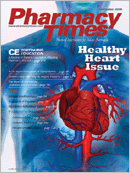Publication
Article
Pharmacy Times
Does Cranberry Juice Increase the Response to Warfarin?
The product labeling of warfarin(Coumadin) lists a large numberof drugs that can potentiallyinteract with it and alter a patient's anticoagulantresponse. The label alsoincludes listings of botanicals that mayinteract with warfarin. Some of theseproducts are reported to containcoumarins (eg, celery, dandelion, licorice,and parsley) that may interact byenhancing the anticoagulant effect ofwarfarin. Others contain salicylates (eg,aloe, clove, ginger, and onion) that mightinhibit platelets and increase the risk ofbleeding. Recently, Bristol-Myers Squibbmodified the warfarin label and patientmedication guide to include a warningabout an enhanced anticoagulant effectwhen patients consume cranberry juiceor other products.
Several cases have been publishedthat report enhanced warfarin effect inpatients consuming cranberry juice.1-3 In2 of these cases,1,3 the patients appearedto have infections and may not havebeen eating their normal diet; both ofthese events can increase the anticoagulantresponse to warfarin. It is possiblethat the cranberry juice added to theother hypoprothrombinemic effects inthese patients produced an elevatedinternational normalized ratio (INR) andhemorrhage.
While cranberry juice contains salicylicacid, it is unlikely that the salicylic acidwould affect the INR or even platelets.4Like many other natural products, cranberryjuice contains compounds thatcould affect the metabolism of warfarinor clotting factors. No definitive studieshave shown cranberry juice can inhibitany metabolic enzyme implicated in themetabolism of warfarin, however. In astudy of the effects of cranberry juice onflurbiprofen (Ansaid) metabolism, a single,240-mL dose of cranberry juice hadno effect on flurbiprofen metabolism.5Flurbiprofen is metabolized by CYP2C9,the same enzyme that is primarilyresponsible for the metabolism of warfarin.Thus, this study indicates that a singledose of cranberry juice given tohealthy persons does not appear toaffect warfarin metabolism. Patients takingcranberry juice for its antimicrobial orantioxidant effects will likely be consuminglarger doses. Indeed, the case reportsof enhanced warfarin effect have allnoted chronic consumption of higherdoses of cranberry juice. Further study isneeded to determine what, if any, dosedependentresponse is observed betweencranberry juice and warfarin.
As with other purported warfarin interactions,several case reports suggestthat cranberry juice may enhance theanticoagulant effect of warfarin. On theother hand, the only prospective trialconducted to date failed to identify aneffect of cranberry juice on CYP2C9activity. The case reports are limited, asoften happens, by the presence of otherfactors that may be responsible forchanges in INR observed in the patients.The prospective study is limited by adesign that may not reflect the typicalconsumption of cranberry juice by allpatients. Additional studies are neededwith the chronic administration of higherdoses of cranberry juice to determine itspotential to alter warfarin response.Insufficient data are available at this timeto evaluate the potential mechanism ofthe interaction between cranberry juiceand warfarin. While it is tempting to focuson the possible CYP2C9 inhibition ofcranberry juice, perhaps other mechanismsare responsible for the effects thathave been observed in some patients.
It has taken a number of years andmany studies to define the interactiveproperties of grapefruit juice.6 Currently,information on the interactive potentialof cranberry juice is very limited. Thelabeling, as a precautionary approach,recommends avoiding cranberry juice orthe consumption of cranberry products iftaking warfarin. While this may appear tobe a very conservative approach consideringthe available data and limited casereports, there is little potential harm inavoiding cranberry products if warfarin isbeing concurrently administered.
Drs. Horn and Hansten are both professorsof pharmacy at the Universityof Washington School of Pharmacy.For an electronic version of this article,including references if any, visitwww.hanstenandhorn.com.
For a list of references, send a stamped, selfaddressedenvelope to: References Department,Attn. A. Rybovic, Pharmacy Times, AscendMedia Healthcare, 103 College Road East,Princeton, NJ 08540; or send an e-mailrequest to: [email protected].

Newsletter
Stay informed on drug updates, treatment guidelines, and pharmacy practice trends—subscribe to Pharmacy Times for weekly clinical insights.






